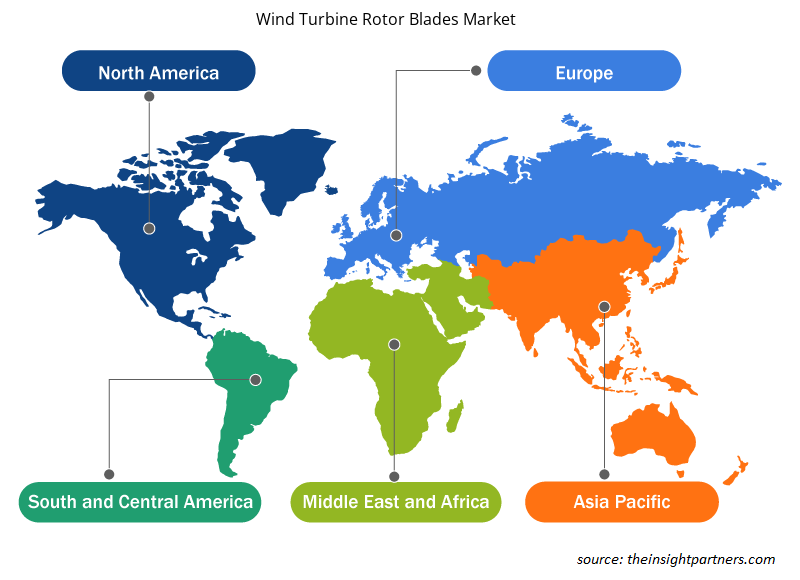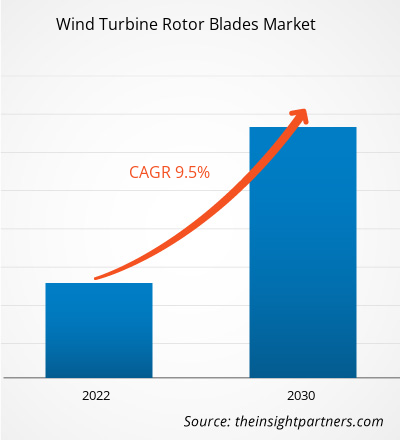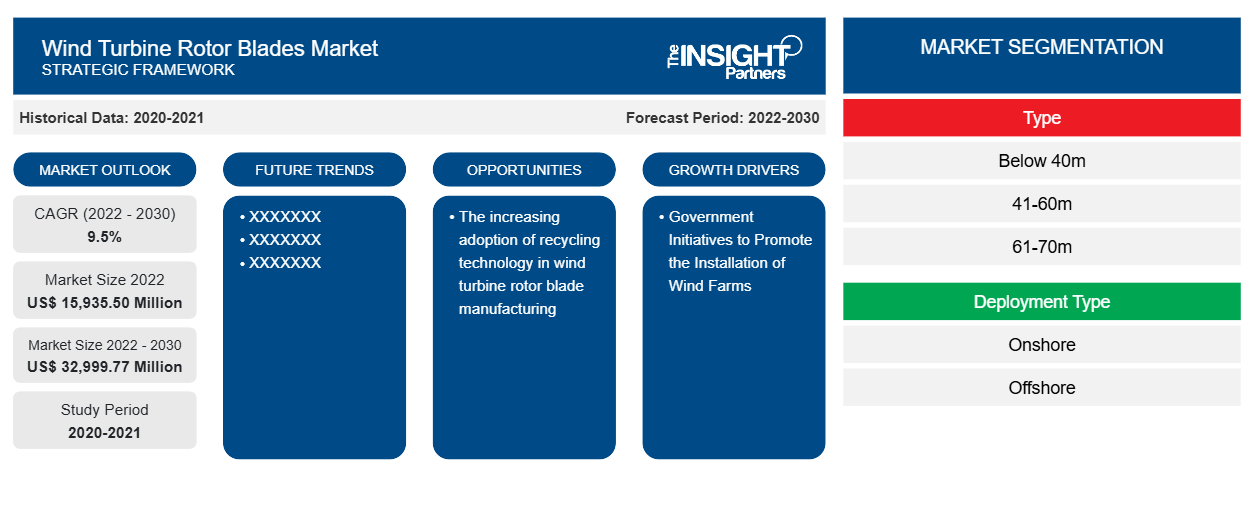풍력 터빈 로터 블레이드 시장 규모는 2022년에 159억 3,550만 달러로 평가되었으며, 2030년까지 329억 9,977만 달러에 도달할 것으로 예상됩니다. 2022~2030년 동안 연평균 성장률 9.5%로 성장할 것으로 예상됩니다.
풍력 터빈 로터 블레이드 제조에 재활용 기술을 도입하는 추세가 확대되는 것은 앞으로도 시장의 주요 추세로 남을 것으로 보인다.
풍력 터빈 로터 블레이드 시장 분석
풍력 터빈 로터 블레이드 시장은 특히 원격 지역에서 육상 및 해상 풍력 발전 프로젝트의 수가 증가함에 따라 분석 기간 동안 상당한 성장을 경험할 것으로 예상됩니다. 또한 풍력, 태양광, 지열 등과 같은 재생 에너지원을 통한 발전에 집중하여 탄소 배출을 줄이기 위한 정부 규제가 2022 년부터 2030년까지 시장 성장을 견인할 것으로 예상됩니다. 게다가 전 세계적으로 풍력 발전소를 설치하려는 정부 이니셔티브가 향후 몇 년 동안 시장 성장을 촉진할 것으로 예상됩니다.
풍력 터빈 로터 블레이드 시장 개요
인구 증가와 산업화로 인해 전 세계적으로 에너지 수요도 증가하고 있습니다. 에너지 소비 증가로 인해 개발도상국과 선진국에서 재생 에너지 발전에 대한 필요성도 높아졌습니다. 이로 인해 전 세계적으로 풍력 발전 인프라에 대한 수요가 증가했습니다. 풍력 발전은 다른 재생 에너지원에 비해 전 세계적으로 중요성과 수용성이 높아졌습니다. 풍력 터빈 로터 블레이드, 터빈, 기초, 샤프트 및 기타 구성 요소의 설계 및 개발 분야에서 기술이 발전하면서 풍력 에너지 채택이 크게 진전되었고 가용 풍력에서 최대 전력을 얻을 수 있었습니다. 국제 재생 에너지 기구(IRENA)에 따르면 전 세계 풍력 설치 용량은 2021년 825GW에서 2023년 말까지 1,017GW에 도달했습니다. 따라서 풍력 에너지의 이점과 유리한 정책, 인센티브 및 세금 환급으로 인해 향후 몇 년 동안 풍력 설치 용량이 증가할 것으로 예상됩니다. 전 세계적으로 풍력 설비 용량이 이처럼 증가하는 것은 풍력 터빈 로터 블레이드 시장을 주도하는 주요 요인이 될 것으로 예상됩니다.
귀하의 요구 사항에 맞게 이 보고서를 사용자 정의하세요
이 보고서의 일부 또는 국가 수준 분석, Excel 데이터 팩을 포함하여 모든 보고서에 대한 사용자 정의를 무료로 받을 수 있으며 신생 기업 및 대학을 위한 훌륭한 혜택과 할인 혜택을 이용할 수 있습니다.
-
이 보고서의 주요 시장 동향을 알아보세요.이 무료 샘플에는 시장 동향부터 추정 및 예측까지 다양한 데이터 분석이 포함됩니다.
풍력 터빈 로터 블레이드 시장 동인 및 기회
시장 우대를 위한 풍력발전소 설치 촉진을 위한 정부 이니셔티브
다양한 국가의 다양한 정부에서 풍력 에너지 프로젝트 설치를 늘리기 위한 정책, 보조금 및 투자 측면에서 지원을 늘리면 분석 기간 동안 풍력 터빈 로터 블레이드 시장 성장이 촉진될 것으로 예상됩니다. 인도 정부는 가속 감가상각 혜택 및 풍력 발전기의 특정 구성 요소에 대한 양보적 관세 또는 세금 면제와 같은 다양한 재정 및 금융 인센티브를 제공하여 민간 부문 자금을 통해 국내 풍력 발전소를 홍보하고 있습니다. 예를 들어, 독일은 풍력 에너지 확장을 가속화하기 위한 법안을 도입할 계획입니다. 이 새로운 법률은 연방 주에서 육상 풍력 에너지 확장에 대한 구속력 있는 지역 목표를 적용할 것입니다. 2022년 4월, 독일은 이스터 패키지라는 역사적인 패키지의 도움으로 2025년부터 연간 10GW 이상의 해상 풍력 목표를 배치할 계획이었습니다. 이는 독일 에너지 정책에서 가장 심오한 일련의 변화입니다. 이러한 정부 이니셔티브의 도움으로 2030년까지 독일의 전기 수요의 80%가 재생 에너지원에서 생산된 전기로 충당될 것입니다 . 풍력 발전소 설치를 촉진하기 위한 전 세계의 이러한 정부 이니셔티브는 2022년부터 2030년까지 시장 성장을 촉진할 것으로 예상됩니다.
부유 풍력 기술에 대한 관심 증가
부유 풍력 기술은 바다에 떠 있는 구조물에 장착된 해상 풍력 터빈으로, 터빈이 수심에서 전기를 생산하도록 합니다. 부유 또는 해상 풍력 기술은 혹독한 환경 조건에서 매우 효율적이므로 엄청난 양의 전력을 생산할 수 있습니다. 이 부유 풍력 기술은 중국, 독일, 일본, 영국, 프랑스, 벨기에, 덴마크 등 다양한 국가에서 전 세계적으로 채택되었습니다. 부유 풍력 기술 채택의 성장 전망은 주로 기술 발전, 관련 이점, 다양한 서비스 제공업체에서 제공하는 턴키 솔루션의 증가에 기인합니다. 다양한 국가에서 청정 에너지 목표 달성에 대한 인식이 커지면서 부유 해상 풍력에 대한 수요가 증가하고 있으며, 이는 풍력 터빈 로터 블레이드 시장의 성장에 잠재적인 기회를 제공합니다.
Floating Offshore Wind Centre of Excellence 보고서는 신생 재생 에너지 기술에서 주요 참여자가 될 준비가 가장 된 22개국을 파악했습니다. 예를 들어, 2023년 영국에 본사를 둔 Octopus Energy는 2030년까지 해상 풍력에 200억 달러를 투자할 계획이라고 발표했습니다. 2023년 미국 정부는 4번째 해상 풍력 프로젝트를 승인했습니다. 이 발표는 2030년까지 30기가톤(GW)의 해상 풍력 발전 용량을 배치한다는 미국의 목표를 향한 또 다른 발걸음을 의미합니다. 또한 2022년 1월 영국 정부는 영국에서 생성된 재생 에너지를 늘리기 위해 29억 7천만 달러를 제시하면서 각각 최대 9억 5,923만 달러를 수여받을 11개의 재생 에너지 프로젝트를 발표했습니다. 전 세계적으로 해상 또는 부유 풍력 기술에 대한 이러한 투자는 향후 몇 년 동안 시장 성장을 촉진할 것으로 예상됩니다.
풍력 터빈 로터 블레이드 시장 보고서 세분화 분석
풍력 터빈 로터 블레이드 시장 분석의 도출에 기여한 주요 세그먼트는 유형 및 응용 프로그램입니다.
- 유형에 따라 풍력 터빈 로터 블레이드 시장은 40m 미만, 41-60m, 61-70m, 70m 이상으로 나뉩니다. 70m 이상 세그먼트는 2022년에 가장 큰 시장 점유율을 차지했습니다.
- 응용 프로그램을 기준으로 시장은 육상 및 해상으로 세분화됩니다. 육상 세그먼트는 2022년에 더 큰 시장 점유율을 차지했습니다.
지역별 풍력 터빈 로터 블레이드 시장 점유율 분석
풍력 터빈 로터 블레이드 시장 보고서의 지리적 범위는 주로 북미, 아시아 태평양, 유럽, 중동 및 아프리카, 남미 및 중부 아메리카의 5개 지역으로 나뉩니다.
아시아 태평양 지역은 2022년 풍력 터빈 로터 블레이드 시장을 장악했습니다. 아시아 태평양 지역에는 중국, 호주, 인도, 한국, 일본 및 아시아 태평양의 나머지 지역이 포함됩니다. 아시아 태평양 지역은 2022년 전 세계적으로 풍력 터빈 로터 블레이드 시장에서 두 번째로 큰 시장 점유율을 차지했으며 예측 기간 동안 가장 빠른 CAGR로 확대될 것으로 예상됩니다. 강력한 육상 산업과 이 지역 전역에 많은 수의 풍력 터빈 로터 블레이드 제조업체가 있는 것이 높은 시장 점유율의 원인입니다. 또한 중국, 일본, 한국 및 동남아시아에서 확장되는 해상 부문은 이 지역 전역의 풍력 터빈 로터 블레이드 공급업체 시장을 활성화하고 있습니다. 또한 이 지역의 육상 및 해상 풍력 발전소 설치에 대한 투자 증가로 인해 2022년부터 2030년까지 풍력 터빈 로터 블레이드 수요가 증가할 것으로 예상됩니다.
풍력 터빈 로터 블레이드 시장 지역 통찰력
Insight Partners의 분석가들은 예측 기간 동안 풍력 터빈 로터 블레이드 시장에 영향을 미치는 지역적 추세와 요인을 철저히 설명했습니다. 이 섹션에서는 북미, 유럽, 아시아 태평양, 중동 및 아프리카, 남미 및 중미의 풍력 터빈 로터 블레이드 시장 세그먼트와 지리에 대해서도 설명합니다.

- 풍력 터빈 로터 블레이드 시장에 대한 지역별 데이터 얻기
풍력 터빈 로터 블레이드 시장 보고서 범위
| 보고서 속성 | 세부 |
|---|---|
| 2022년 시장 규모 | 15,935.50백만 달러 |
| 2030년까지 시장 규모 | 32,999.77백만 달러 |
| 글로벌 CAGR (2022-2030) | 9.5% |
| 역사적 데이터 | 2020-2021 |
| 예측 기간 | 2022-2030 |
| 다루는 세그먼트 |
유형별로
|
| 포함된 지역 및 국가 |
북아메리카
|
| 시장 선도 기업 및 주요 회사 프로필 |
|
풍력 터빈 로터 블레이드 시장 참여자 밀도: 비즈니스 역학에 미치는 영향 이해
풍력 터빈 로터 블레이드 시장은 소비자 선호도의 변화, 기술 발전, 제품의 이점에 대한 인식 증가와 같은 요인으로 인해 최종 사용자 수요가 증가함에 따라 빠르게 성장하고 있습니다. 수요가 증가함에 따라 기업은 제품을 확장하고, 소비자의 요구를 충족하기 위해 혁신하고, 새로운 트렌드를 활용하여 시장 성장을 더욱 촉진하고 있습니다.
시장 참여자 밀도는 특정 시장이나 산업 내에서 운영되는 회사나 기업의 분포를 말합니다. 주어진 시장 공간에 얼마나 많은 경쟁자(시장 참여자)가 존재하는지 그 규모나 전체 시장 가치에 비해 나타냅니다.
풍력 터빈 로터 블레이드 시장에서 운영되는 주요 회사는 다음과 같습니다.
- TPI 복합소재 주식회사
- 베스타스 윈드 시스템 AS
- 에네르콘 GmbH
- LM 풍력발전 AS
- 지멘스 가메사 재생 에너지
- 사
면책 조항 : 위에 나열된 회사는 어떤 특별한 순서에 따라 순위가 매겨지지 않았습니다.

- 풍력 터빈 로터 블레이드 시장 주요 업체 개요를 알아보세요
풍력 터빈 로터 블레이드 시장 뉴스 및 최근 개발
풍력 터빈 로터 블레이드 시장은 1차 및 2차 연구 이후의 정성적, 정량적 데이터를 수집하여 평가합니다. 여기에는 중요한 기업 간행물, 협회 데이터 및 데이터베이스가 포함됩니다. 풍력 터빈 로터 블레이드 시장의 몇 가지 개발 사항은 다음과 같습니다.
- TPI Composites, Inc.(TPI)는 세계를 탈탄소화하고 전기화하기 위한 혁신적이고 지속 가능한 솔루션을 제공하는 회사로, GE Renewable Energy(GE)와의 공급 계약을 2025년까지 연장한다고 발표했습니다. General Electric과 TPI Composites, Inc는 GE의 차세대 블레이드 유형 개발을 위해 협력할 계획이며, GE가 TPI와 함께 운영하는 9개 생산 시설 외에도 2023년에 더 많은 생산 시설을 추가할 계획입니다. (출처: TPI Composites, Inc., 보도자료, 2023년 1월)
- Siemens Gamesa Renewable Energy는 포르투갈 바고스에 있는 육상 풍력 터빈 블레이드 생산 시설의 운영에 종사하는 Ria Blades, SA의 최종 인수와 공장 운영에 필요한 기타 추가 자산을 발표했습니다. (출처: Siemens Gamesa Renewable Energy, 보도자료, 2023년 4월)
풍력 터빈 로터 블레이드 시장 보고서 범위 및 제공물
"풍력 터빈 로터 블레이드 시장 규모 및 예측(2020-2030)" 보고서는 아래 영역을 포괄하는 시장에 대한 자세한 분석을 제공합니다.
- 범위에 포함된 모든 주요 시장 세그먼트에 대한 글로벌, 지역 및 국가 수준의 풍력 터빈 로터 블레이드 시장 규모 및 예측
- 풍력 터빈 로터 블레이드 시장 동향 및 드라이버, 제약 및 주요 기회와 같은 시장 역학
- 자세한 PEST 및 SWOT 분석
- 주요 시장 동향, 글로벌 및 지역 프레임워크, 주요 업체, 규정 및 최근 시장 개발 사항을 포괄하는 풍력 터빈 로터 블레이드 시장 분석
- 시장 집중도, 히트맵 분석, 유명 업체 및 풍력 터빈 로터 블레이드 시장의 최근 개발 사항을 다루는 산업 환경 및 경쟁 분석
- 자세한 회사 프로필
- 과거 분석(2년), 기준 연도, CAGR을 포함한 예측(7년)
- PEST 및 SWOT 분석
- 시장 규모 가치/거래량 - 글로벌, 지역, 국가
- 산업 및 경쟁 환경
- Excel 데이터세트
최근 보고서
관련 보고서
사용 후기
구매 이유
- 정보에 기반한 의사 결정
- 시장 역학 이해
- 경쟁 분석
- 고객 인사이트
- 시장 예측
- 위험 완화
- 전략 기획
- 투자 타당성 분석
- 신흥 시장 파악
- 마케팅 전략 강화
- 운영 효율성 향상
- 규제 동향에 발맞춰 대응























 무료 샘플 받기 - 풍력 터빈 로터 블레이드 시장
무료 샘플 받기 - 풍력 터빈 로터 블레이드 시장